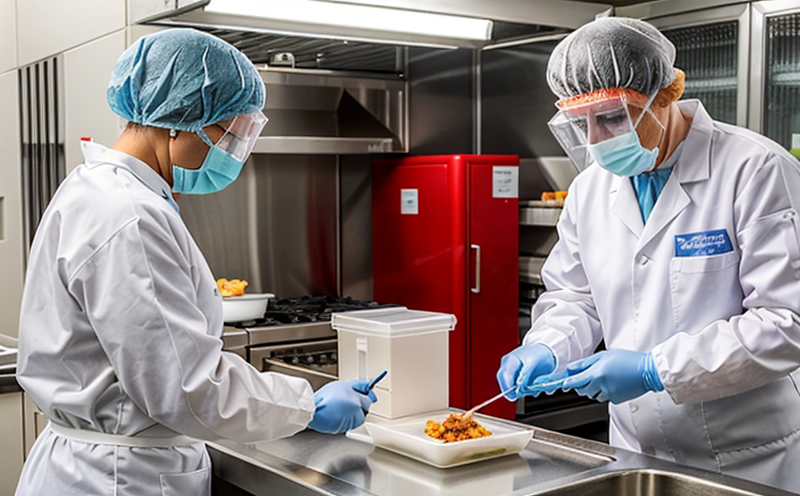USP Viral Contamination Testing in Food Ingredients
The United States Pharmacopeia (USP) [1] standard Viral Contamination of Pharmaceutical and Non-Pharma Products, specifically USP <2251>, addresses the potential contamination of food ingredients with viruses. This stringent protocol ensures that foods remain safe for consumption by minimizing the risk of viral transmission through contaminated raw materials or intermediates used in their production.
Viral contamination can pose significant health risks, particularly from pathogens like norovirus, hepatitis A virus, and rotavirus, which are known to be stable in various environmental conditions. The USP protocol aims to safeguard the integrity of food ingredients by establishing a robust testing framework that manufacturers must adhere to.
The testing process involves several critical steps:
- Sample Collection: Properly collecting samples from raw materials and intermediates is crucial for accurate analysis. Samples should represent various parts of the batch or lot, ensuring comprehensive coverage.
- Preparation: Raw materials are prepared according to standard laboratory protocols to ensure consistency in testing conditions.
- Testing Methodology: Viral detection utilizes advanced molecular techniques such as quantitative PCR (qPCR) and next-generation sequencing (NGS). These methods enable the identification of viral nucleic acids even at trace levels.
- Data Analysis: Results are analyzed to determine compliance with USP <2251> requirements, providing insights into potential contamination risks.
The USP protocol is particularly important for manufacturers of food ingredients who aim to comply with international safety standards. By adhering to this testing procedure, companies can ensure that their products meet stringent regulatory requirements and contribute to public health.
In summary, the USP <2251> testing ensures that food ingredients are free from viral contamination, thereby safeguarding consumer health and maintaining brand integrity in a highly regulated market. This service is essential for manufacturers seeking to maintain compliance with international standards and to build trust among consumers.
| Step | Description | Objective |
|---|---|---|
| Sample Selection | Select batches based on risk assessment. | Prioritize high-risk samples for testing. |
| Sampling Frequency | Conduct monthly sampling during peak production periods. | Maintain consistent monitoring of potential contamination risks. |
| Method | Principle | Advantages |
|---|---|---|
| Quantitative PCR (qPCR) | Detects viral nucleic acids quantitatively. | High sensitivity and specificity; fast results. |
| Next-Generation Sequencing (NGS) | Identifies viral sequences through comprehensive sequencing. | Promotes thorough identification of unknown viruses. |
International Acceptance and Recognition
The USP <2251> protocol is widely recognized and accepted by regulatory authorities around the world. Its implementation ensures that food ingredients meet stringent international safety standards, thereby facilitating global trade.
- United States Food and Drug Administration (FDA): The FDA accepts USP <2251> as a guideline for ensuring ingredient safety in food products.
- European Medicines Agency (EMA): EMA recognizes the importance of viral contamination testing to ensure product safety within Europe.
- World Health Organization (WHO): WHO guidelines recommend USP <2251> as a best practice for ingredient safety.
The widespread acceptance and recognition of USP <2251> underscore its significance in the global food industry. Compliance with this protocol is essential for manufacturers aiming to access international markets while ensuring product safety.
Competitive Advantage and Market Impact
Adhering to the USP <2251> testing standard offers several competitive advantages in the food ingredient market. By demonstrating a commitment to ingredient safety, companies can:
- Earn consumer trust through transparent product information.
- Enhance brand reputation and loyalty.
- Reduce risk of recalls or legal actions due to contamination issues.
In an increasingly globalized market, compliance with USP <2251> can differentiate companies from competitors who may not adhere to such stringent testing protocols. This commitment to safety and quality can significantly enhance a company's competitive position and long-term sustainability.
Use Cases and Application Examples
The USP <2251> protocol finds application in various food ingredient sectors, including dairy products, meat, grains, spices, and dietary supplements. Here are some use cases:
| Sector | Application |
|---|---|
| Dairy Products | Testing for viral contamination in milk and dairy ingredients. |
| Meat | Ensuring meat products are free from viral contamination, especially during processing stages. |
| Grains | Detecting potential viral contamination in grain-based ingredients. |
| Spices | Testing for viral contamination in spice blends and extracts. |
The USP <2251> protocol is a critical tool for ensuring that food ingredients are safe for consumption, thereby protecting public health. By implementing this testing standard, manufacturers can ensure compliance with international safety standards and contribute to the overall quality of food products.





